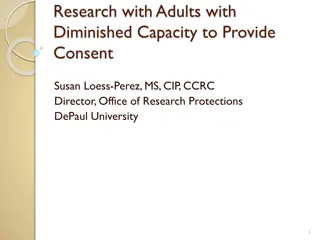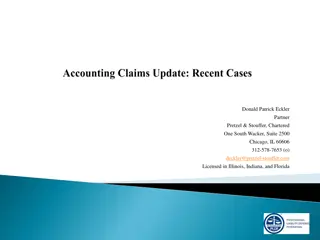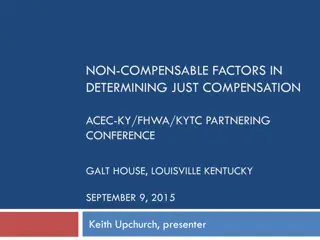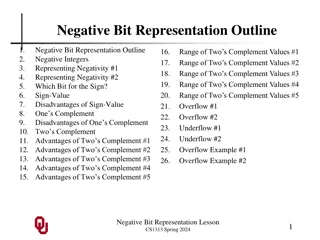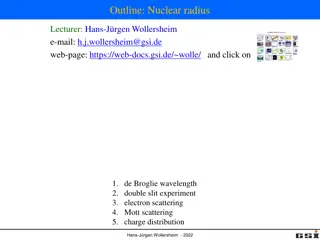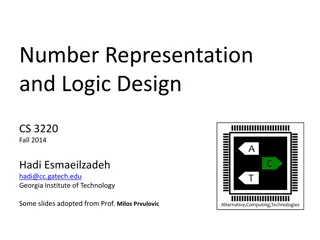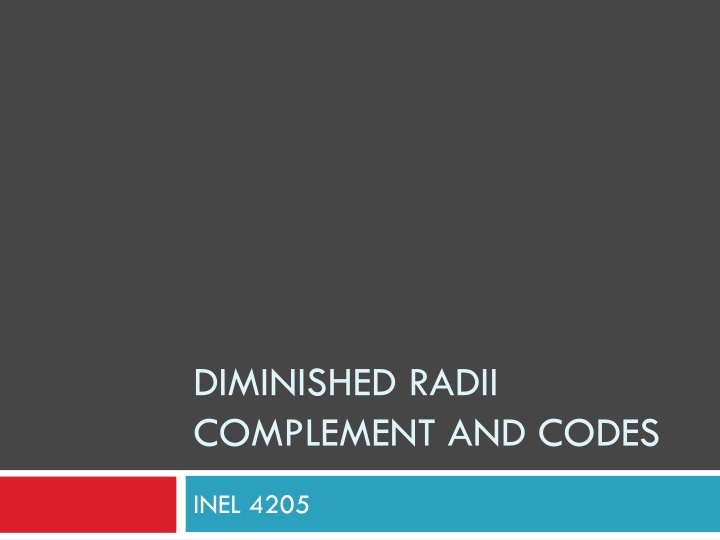
Understanding Complements and Two's Complement in Number Systems
Learn about diminished radii, complements, and codes in numeric systems. Explore definitions, examples for decimal and binary numbers, and the use of two's complement for subtraction. Understand the concept of complements and how they are applied in different number systems.
Download Presentation

Please find below an Image/Link to download the presentation.
The content on the website is provided AS IS for your information and personal use only. It may not be sold, licensed, or shared on other websites without obtaining consent from the author. If you encounter any issues during the download, it is possible that the publisher has removed the file from their server.
You are allowed to download the files provided on this website for personal or commercial use, subject to the condition that they are used lawfully. All files are the property of their respective owners.
The content on the website is provided AS IS for your information and personal use only. It may not be sold, licensed, or shared on other websites without obtaining consent from the author.
E N D
Presentation Transcript
DIMINISHED RADII COMPLEMENT AND CODES INEL 4205
Definition Given a number N in base r having n digits, the (r - l)'s complement of N is defined as: (r" - 1) - N. For Decimal numbers r = 10 and r - 1 = 9, so the 9's complement of N is (10n- 1) - N. Now, 10n represents a number that consists of a single 1 followed by n O's. 10" - I is a number represented by n 9's.
Example for decimal numbers For example, if n = 4, we have 104= 10,000 and 10000- 1 = 09999. It follows that the 9's complement of a decimal number is obtained by subtracting each digit from 9. The 9's complement of 546700 is 999999 - 546700 = 453299. The 9's complement of 012398 is 999999 - 012398 = 987601.
Example for binary numbers (r=2) For example, if n = 4, we have 104= 10000 10000- 1 = 01111. It follows that the 1'st complement of a binary number is obtained by subtracting each digit from 1. The 1'st complement of 101010 is 111111 - 101010 = 010101. The 1'st complement of 001 is 111 - 001 = 110.
Twos Complement of Binary Number Invert every number Example: N=11001100 ones complement =00110011 two s complement = one s complement +1=00110100
Subtracting using twos complement Using 10's complement, subtract 72532 - 3250. M= 10' s complemen t of N = Sum = Discard end carry 105= Answer = Note that M has 5 digits and N has only 4 digits. Both numbers must have the same number of digits; so we can write N as 03250. Taking the lO's complement of N produces a 9 in the most significant position. The occurrence of the end carry signifies that M >=N and the result is positive. 72532 + 96750 169282 -100000 69282
Subtraction using 2s complement with binary numbers X-Y Y-X Y= 2's comp of X = + 0101100 Sum = 1101111 There is no end carry. Answer: Y - X = (2's comp of 1101111) = -0010001 1000011 X = 1010100 and Y = 1000011, X= 2's compY = Sum = Discard end carry 2' = - 10000000 Answer: X - Y = 1010100 + 0111101 10010001 0010001
ASCII Code The ASCII code contains 94 graphic characters that can be printed and 34 nonprinting characters used for various control functions. The graphic characters consist of the 26 uppercase letters (A through Z), the 26 lowercase letters (a through z), the 10 numerals (0 through 9), and 32 special printable characterssuch as %, *, and $.
American Standard Code for Information Interchange (ASCII)
American Standard Code for Information Interchange (ASCII)
Registers Group of binary cells A cell stores one bit of information. Register contains n cells therefore can store n bits of information. The State of the register is an n-tuple number of 1 s and 0 s. The content of a register is a function of the interpretation given to the information stored in it
Register information An interregister transfer operation transfer of information from one register to another. Information from keyboard if ASCII enters in the memory as an 8 bit register. The eighth bit is a parity bit. The 8 bits are stored in the LSBits of the register and later are shifted
Transfer of information among registers
FIGURE 1.2 binary information processing Example of
Table 1.8 Logical Operations Truth Tables of
FIGURE 1.3 Signal levels for binary logic values
FIGURE 1.4 Symbols for digital logic circuits
FIGURE 1.5 Inputoutput signals for gates
FIGURE 1.6 Gates with multiple inputs










